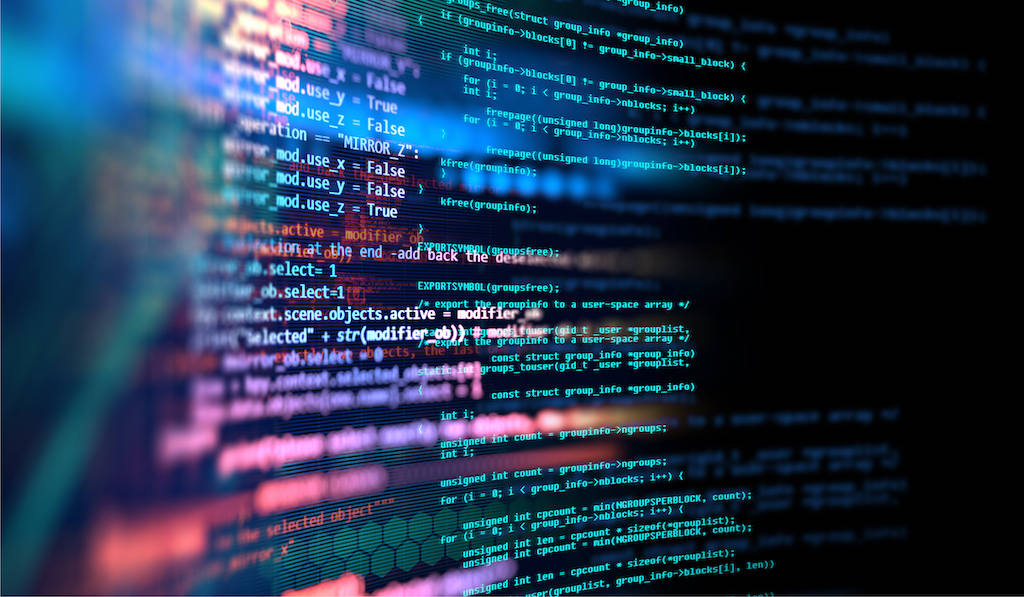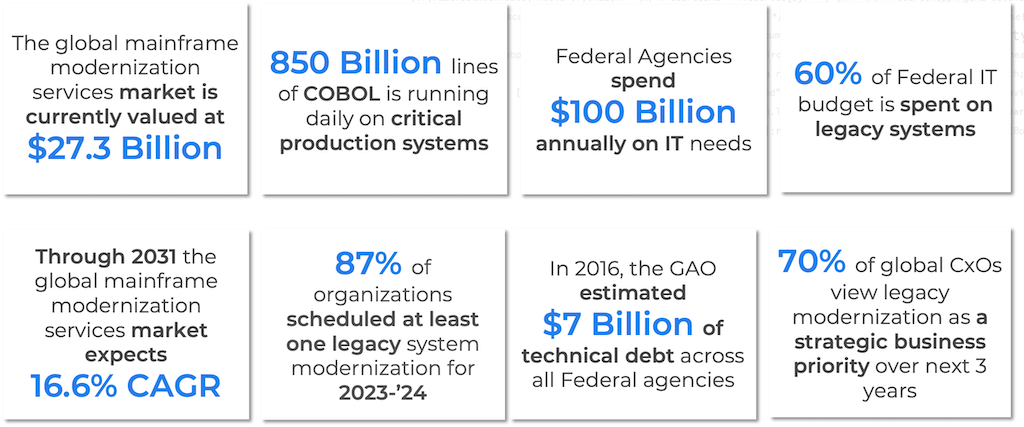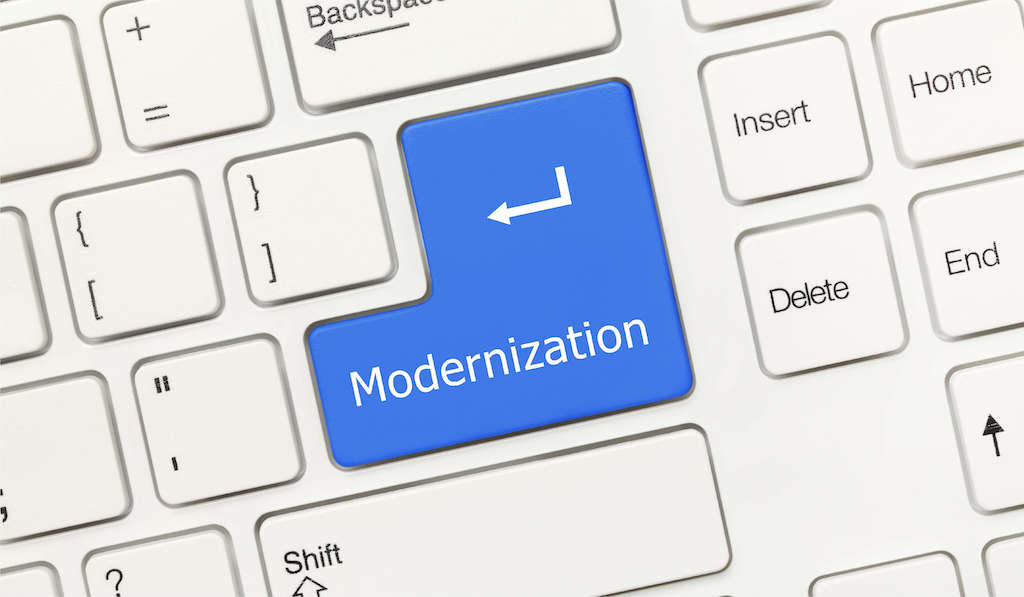DEFINING AND ADVANCING THE FUTURE OF MODERNIZATION
The TSRI team is dedicated to removing the barriers to innovation. We are constantly talking with experts across a broad range of industries, from military to private enterprises to cloud providers, about what modernization means to their organizations, what is coming next in the field, and how they can take advantage of this technology.
In this post, we summarize three topics we hear consistently from customers and partners: the meaning(s) of “modernization”; the motivation to modernize; and how the process has become a movement.
1. What We Mean When We Say "Modernization"

We find people have varying understandings of the phrase “software modernization” depending on their position, needs, and priorities. Options under this umbrella term include line-by-line code conversion, rehosting to a cloud environment, and manual code and architecture refactoring. Really any form of digital transformation, manual or automated, that moves workloads off the mainframe. The Gartner IT Glossary defines Application Modernization Services even more broadly:
“Application modernization services address the migration of legacy to new applications or platforms, including the integration of new functionality to provide the latest functions to the business. Modernization options include replatforming, rehosting, recoding, rearchitecting, reengineering, interoperability, replacement and retirement, as well as changes to the application architecture to clarify which option should be selected.”
Regardless of the terminology, most long-standing organizations understand that it is critical to modernize applications in order to remain competitive. With this rapidly evolving and increasingly necessary industry, it can be a challenge for decision-makers to find and understand their options. At TSRI, our modernization approach simply includes all of it, code, database, architecture, and UI, even CI/CD protocol, while also refactoring for improved quality and performance. And we automate the process at every step of the way for higher rates of accuracy and efficiency; modernizing 100% of the code, the database, and user interfaces from source to target at 99.9X% automation. TSRI’s automated transformation and refactoring uses a unique iterative methodology to not only translate source code into modern languages, but also to improve the quality of the code and optimize the architectures for a modern computing environment in the cloud (or whatever location is right for your application, including on-prem, hybrid, and embedded environments). Our process results in improved application maintainability, readability and performance while reducing security vulnerabilities and technical debt. With automated and intelligent processes, TSRI saves customers time, money, and resources by achieving measurable improvements in weeks instead of months, or years.
Read about our modernization process
2. Top-Down Drivers of Modernization

Look into most Fortune 500 companies and you will find mission-critical applications in need of modernization, 70% according to AWS. Many executives and CEOs are pursuing strategic modernization plans for their organizations over the next few years. Additionally, among the hundreds of technical stakeholders the TSRI team has engaged with in recent months, many director level IT professionals have been instructed by their organization's leadership to begin prioritizing modernization initiatives, if they are not already. It is clear that application modernization is not something that is going to happen in the future — it is necessary now.

Many of our customers are surprised to hear TSRI has been using an automated process to modernize applications for over 28 years already, and that level of experience means our approach is time-tested for success. While we were a pioneer in the field of automated code modernization, mainframe languages have been around well over 65 years, and were designed for a pre-internet world. Now, after 3 decades, the internet has changed the face of every industry, ushering in many changes in how we all do business. As our business models and technologies develop, continuous modernization will be an essential part of ongoing strategic planning for our critical systems, to both utilize modern technologies and identify and avoid liabilities. With the advent of cloud computing in the past decade, modernization now also enables long-standing organizations to take advantage of cloud agility, cost benefits, and scalability.
3. How Code Modernization is Hitting the Mainstream

Despite understanding that modernization is a beneficial and necessary endeavor, many companies and organizations—even those with highly sophisticated business models and/or national security responsibilities—are still running their applications written in languages developed during the era of mainframes, like COBOL and PL/1. Today, the level of security and performance in the cloud is finally on par with the well-established capabilities of mainframes, and the advent of cloud computing offers increased operational efficiencies and future technology readiness, along with providing access to new tools and services that enable discovery and remediation of security vulnerabilities not uncovered before. The movement towards modernization and cloud migration may also help organizations avoid costly operational issues, such as those recently faced by the airline industry, where technical debt resulted in business disruption and unfavorable national news coverage.
Some organizations are understandably still hesitant to begin a modernization project, because their systems are relied upon daily to keep critical operations moving and a major modernization project can sound daunting, with concerns of costly downtime, low ROI, and even introducing new risk to mission-critical systems. Thankfully, through TSRI’s highly accurate and automated architecture-driven modernization solution, these companies can overcome technical debt and capitalize on new technological opportunities with low risk and no business disruption. TSRI's model- and rule-driven software modernization solution is very cost-effective, delivering a high ROI while still producing the highest quality application transformations, routinely meeting and exceeding the code quality, security, and performance standards of many safety-critical industries, including Dept. of Defense, Banking and Finance, and Healthcare.
Read about TSRI’s modernization services
We’d love to hear your modernization stories, definitions and questions. Get in touch with us now to keep the modernization conversation going.
---
Proven by Decades of Results. Prove It for Yourself.
For decades, TSRI clients have been discovering a dramatically faster, more accurate, and cost-effective automated modernization process. We have earned a place as the go-to resource for enterprise corporations, government, military, healthcare, and more. Now prove it for yourself. Find out how the proprietary TSRI modernization process delivers future-ready, cloud-based code in any modern language in a fraction of the time.
See Case Studies
Learn About Our Technology
Get Started on Your Modernization Journey Today!
- Accenture. (n.d.). Mainframe Migration. Accenture. https://www.accenture.com/us-en/blogs/cloud-computing/mainframe-migration
- CIO. (2021, August 16). Moving beyond legacy: The C-suite guide to application modernisation. Be Ready. https://be-ready.cio.com/collection/application-modernisation/article/moving-beyond-legacy-the-c-suite-guide-to-application-modernisation
- Tata Consultancy Services. (2022, January 18). Mainframe and Legacy Modernisation Top Priority - TCS Survey. Tata World. https://www.tataworld.com/news/openinside/mainframe-and-legacy-modernisation-top-priority-tcs-survey
- Transparency Market Research. (2022, February 9). Mainframe Modernization Services Market to Expand at CAGR of 16.6%: Rising Need for Modernizing Technology Infrastructure to Boost Global Market, Notes TMR. PR Newswire. https://www.prnewswire.com/news-releases/mainframe-modernization-services-market-to-expand-at-cagr-of-16-6-rising-need-for-modernizing-technology-infrastructure-to-boost-global-market-notes-tmr-301421602.html
- Parrish, T. (2022, February 10). COBOL wants to find out just how popular it really is. TechRadar. https://www.techradar.com/news/cobol-wants-to-find-out-just-how-popular-it-really-is
- Simon, A. (2022, December 12). Shifting left on day one. FCW. https://fcw.com/comment/2022/12/shifting-left-day-one/380823/
- Clark, S. (2022, March 31). Senate HSGAC Approves Legacy IT Reduction Act, Blocks Funding. MeriTalk. https://www.meritalk.com/articles/senate-hsgac-approves-legacy-it-reduction-act-blocks-funding/
- Manyika, J., Chui, M., Miremadi, M., Bughin, J., George, K., Willmott, P., & Dewhurst, M. (2020, May 14). How COVID-19 has pushed companies over the technology tipping point—and transformed business forever. McKinsey & Company. https://www.mckinsey.com/business-functions/strategy-and-corporate-finance/our-insights/how-covid-19-has-pushed-companies-over-the-technology-tipping-point-and-transformed-business-forever
- Konkel, F. (2022, March 31). New bill would mandate legacy IT inventories, modernization plans. Federal News Network. https://federalnewsnetwork.com/congress/2022/03/new-bill-would-mandate-legacy-it-inventories-modernization-plans/
